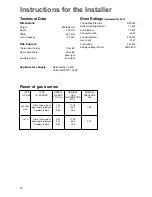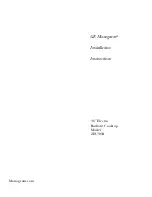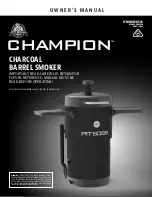
6
Condensation and steam
When food is heated it produces steam in the same
way as a boiling kettle. The oven vents allow some of
this steam to escape. However,
always stand back
from the oven when opening the oven door
to allow
any build up of steam or heat to release.
If the steam comes into contact with a cool surface on
the outside of the oven, e.g. a trim, it will condense and
produce water droplets. This is quite normal and is not
a fault with the oven.
To prevent discoloration, regularly wipe away
condensation and also soilage from surfaces.
Cookware
• Use any oven proof cookware which will withstand
temperatures of 250°C.
• Baking trays, oven dishes, etc. should not be placed
directly against the grid covering the fan at the back
of the oven, or placed on the oven base.
• Do not use baking trays larger than 30 cm x 35 cm
(12 in x 14 in) as they will restrict the circulation of
heat and may affect performance.
Hints and Tips
Storage Drawer
The storage drawer is located underneath the oven
cavity.
During cooking the storage drawer may become hot if
the oven is on high for a long period of time, therefore
flammable materials such as oven gloves, tea towels,
plastic aprons etc. should not be stored in the drawer.
Oven accessories such as baking sheets, will also
become hot, therefore care should be taken when
removing these items from the drawer whilst the oven
is in use or still hot.
Before the First Use of the Oven
Remove
all packaging
, both inside and outside
the oven,
before using the oven.
Before first use, the oven should be heated without food.
During this time, an unpleasant odour may be emitted.
This is quite normal.
1.
Switch the oven function control knob to
conventional cooking
.
2.
Set the thermostat control knob to MAX.
3.
Open a window for ventilation.
4.
Allow the oven to run empty for
approximately 45 minutes.
This procedure should be repeated with the fan cooking
and grill function for approximately 5-10 minutes.
• Always cook with the oven door closed.
• Stand clear when opening the drop down oven
door. Do not allow it to fall open - support the
door using the door handle, until it is fully open.
• The oven has fourteen shelf levels.
• The shelf positions are counted from the bottom of
the oven.
• It is important that these shelves are correctly
positioned as shown in Fig. 7.
•
Do not place cookware directly on the oven base.
Using the Oven
Fig. 7
The effects of dishes
on cooking results
Dishes and tins vary in their thickness, conductivity,
colour, etc. which affects the way they transmit heat to
the food inside them.
A
Aluminium, earthenware, oven glassware and bright
shiny utensils reduce cooking and underneath
browning.
B
Enamelled cast iron, anodized aluminium, aluminium
with non-stick interior and coloured exterior and dark,
heavy utensils increase cooking and underneath
browning.
FO 2078






































